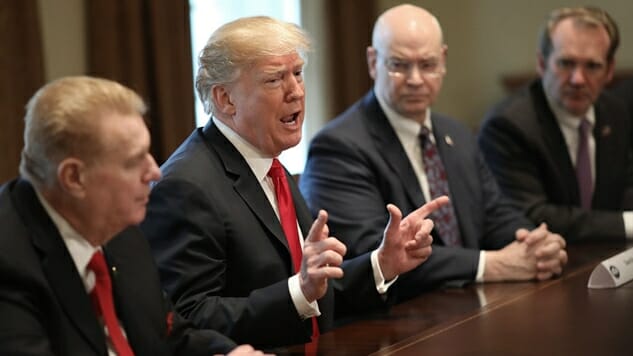Trump’s Tremendously Twisted Logic on Steel and Aluminum Tariffs
Photo by Win McNamee/Getty
If you’re the kind of person who takes their cues on what to believe from your political leaders, you are probably incredibly confused by our Republican president’s new steel tariffs. Firstly, “tariff” is just a fancy word for a tax. If you impose a 20% tariff on something, you’re simply raising the price on that product 20% by adding that additional cost to producing it. Greg Owens, the president of Sherill Manufacturing, said that as a result of Trump’s proposed tax hike, manufacturers “will be paying higher prices for our foreign-produced, imported stainless steel going forward, ironically making us less competitive against foreign-finished goods.”
Ben Sasse, Republican Senator from Nebraska said “Let’s be clear: The President is proposing a massive tax increase on American families. Protectionism is weak, not strong. You’d expect a policy this bad from a leftist administration, not a supposedly Republican one.” Orrin Hatch, the second most powerful Republican in the Senate, said “Tariffs on steel and aluminum are a tax hike the American people don’t need and can’t afford.”
Sherrod Brown, a possible candidate for Democratic nominee for president in 2020, praised Trump, saying: “This welcome action is long overdue for shuttered steel plants across Ohio and steelworkers who live in fear that their jobs will be the next victims of Chinese cheating. President Trump must follow through on his commitment today to save American steel jobs and stop Chinese steel overcapacity from continuing to infect global markets. If we fail to stand up for steel jobs today, China will come after other jobs up and down the supply chain tomorrow.”
So what’s actually going on with steel tariffs? First off, Ben’s Ass doesn’t know what the hell he’s talking about (per usual). Republican President George W. Bush imposed steel tariffs from 2002 to 2004. Republican President Ronald Reagan enacted tariffs on Japanese-made computers, televisions and power tools in 1987. Republican President Richard Nixon implemented Executive Order 11615, which placed controls on wages, rents, prices and salaries. Republican President Herbert Hoover signed the Smoot-Hawley Tariff Act into law, which raised tariffs on over 20,000 imported goods. Ben Sasse may like to live in a fairytale where Republican presidents let the free market run its course, but that simply doesn’t square up with reality. What Trump is doing isn’t out of the norm.
But that doesn’t mean that it’s smart. Trump has asked for a 25% tariff on all imported steel and 10% on aluminum. Peter Navarro, director of the White House National Trade Council told CNN’s Face the Nation that “China is at the root of the problem. China has tremendous overcapacity in both aluminum and steel. They flood the world market and this whittles down to our shores.” One problem? The United States doesn’t import that much steel from China (roughly 2% of our total steel imports come from China). Per the United States Department of Commerce, here are the top 10 countries that the U.S. imports its steel from:
1. Canada – 16%
2. Brazil – 13%
3. South Korea – 10%
4. Mexico – 9%
5. Russia – 9%
6. Turkey – 7%
7. Japan – 5%
8. Taiwan – 4%
9. Germany – 3%
10. India – 2%
So the message from both Trump and Democratic Senator Sherrod Brown is that the world’s largest importer of steel can punish China by taxing a bunch of countries that aren’t China. The word “strategery” came into being during the Bush administration thanks to Will Ferrell’s incredible parody of W. on SNL, but this decision is the literal definition of that word. In retaliation for Trump’s attempted bank shot off our allies and into China, the European Union announced that they would initiate tariffs on American exports to Europe like Harley-Davidson motorcycles, Kentucky bourbon and blue jeans.
it’s pretty funny that the president farted out a tariff on a whim and the EU immediately launched a well-thought-out plan to target industries from the speaker’s, senate majority leader’s, and house minority leader’s states https://t.co/Z515L0fb7L
— chris hooks (@cd_hooks) March 3, 2018
Trump is now threatening a tariff on cars from the EU, and if you were wondering why Vladimir Putin wanted Trump in the White House, this is a prime example. In an attempt to play domestic politics, Trump imposed real-world consequences on U.S. allies, and now we are in a tit-for-tat verbal escalation of a trade war with the European Union that could become very real very fast. And for what? What’s the argument in favor of the world’s largest steel importer imposing a 25% tax increase on steel imports? The case was made in Forbes yesterday:
China has been manipulating the global markets through their cheap currency policy for the better part of the past 25 years. In pinning down their currency, they cornered the world’s export market. And in the process, they emerged as the second largest economy in the world. They also accumulated the world’s largest reserve of foreign currencies, which they plowed into global credit markets (mainly our Treasurys) to fuel cheap credit, which ultimately led to the global credit bubble and bust (the global financial crisis). We buy their cheap stuff. They take our dollars and buy Treasurys, supplying more credit to us to buy more of their cheap stuff. And so the cycle goes.
Currencies are the natural balancing mechanism to prevent this bubble/global imbalance from forming. When freely traded in an open economy, the market demand for yuan, given the aggressive growth in the economy, would have driven the value of China’s currency higher, making its exports less attractive, and therefore slowing their breakneck growth and wealth accumulation in China, and its ability to fuel global credit. But of course, the government determines the value of the yuan, and keeping the currency cheap is part of the economic model in China (still).
The tariff threats address metals, but the currency is a key tool that makes it all happen. For those that fear retaliation (a historic response to protectionism), this is retaliation… for 20 years of wealth transfer.
The line on currency manipulation is 100% true, but this is where all the arguments in favor of protectionism run into trouble: how does taxing our allies on steel and aluminum (and us, since capitalism always passes the costs down to the consumer), stop China from manipulating their currency? It’s never something that gets addressed because the data is undeniable: this is not a tax on China. We don’t import that much steel from them. It’s a tax on our allies.
There are serious issues with American trade deals. We have effectively hollowed out our middle class in order for industrialists to move manufacturing to the poorest areas of the world—raising folks out of extreme poverty (but not too far) at the expense of the Western middle class. Poorer classes across the globe get a slight bump in wages, industrialists see their bottom lines skyrocket thanks to using inexpensive labor (almost always the largest cost for any business) and American workers get screwed solely because we pay something resembling a living wage here. This is the story of the decline of American manufacturing, and no number of tariffs will reverse the fact that menial factory jobs are never coming back. Automation is to blame more than outsourcing, but that’s besides the point. Trump wants to tax Americans and our allies in order to reclaim some vague concept of American manufacturing.
If Ben Sasse were an honest politician, he would have cited the failure of Bush’s tariffs instead of pretending that four of the last six Republican presidents didn’t enact some form of protectionism. Bush rescinded his steel tariffs after 21 months, and, per The Washington Post:
key administration officials have concluded that Bush’s order has turned into a debacle. Some economists say the tariffs may have cost more jobs than they saved, by driving up costs for automakers and other steel users. Politically, the strategy failed to produce union endorsements and appears to have hurt Bush with workers in Michigan and Tennessee — also states at the heart of his 2004 strategy.
“They tried to play politics, and it looked like it was working for a while,” said Bruce Bartlett, a conservative economist with ties to the administration. “But now it’s fallen apart.”
One study found that Bush’s tariffs cost the economy roughly 200,000 jobs. Tariffs like this simply do not address the root of the problem, and they are superfluous political theater which wind up harming the people they aim to help.
Protectionism is a function of America refusing to accept a technologically and politically changing world—instead trying to punish its way into reversing the march of time. This strategy is analogous to getting into a bar fight and spending the entire time punching yourself and your friends in the face. American manufacturing has been on a steady decline since 1945. This is not a story of failed government policy, but of a rapidly changing and interconnected world.
Trump’s protectionism is closer to the historic status quo than the world that modern Americans have grown up in. The United States had a protectionist trade policy from its first tariff passed in 1816 to the end of World War II in 1945. This chart demonstrates the dramatic drop-off post-WWII—as we became a country interested in complete free trade only after all our competitors were wiped out by the greatest war in the history of mankind. Now that the rest of the world has caught up to us, we are stuck debating a 19th century trade policy and a late 20th century trade policy—neither of which addresses the root cause of the problem: those who control any industry receive the largest benefit thanks to the nature of capitalism. Wages aren’t low because of some amorphous Chinese currency manipulation, but because our modern-day Robber Barons decided to stop paying their workers commensurate salaries with their production beginning in the 1970s.
The result of trickle down economics pic.twitter.com/kVekrEWtfA
— ???? (@onlygoodposts1) November 9, 2017
We live in a world where 80% of CEOs said they would pass up an investment which would fuel a decade of innovation if it meant they would miss a quarter of earnings results. Short-term profits are the only real goal of modern capitalism, and this leads companies to reduce their costs as much as possible. Labor in the United States is expensive, and unless we either dramatically lower living standards and wages in this country or shift the power dynamic toward workers and away from owners of capital, no number of tariffs will fix the very real problem underlying this entire ordeal. American capitalists, not foreign industrialists, are depressing wages and killing jobs in the name of hoarding the almighty dollar.
Jacob Weindling is a staff writer for Paste politics. Follow him on Twitter at @Jakeweindling.







































